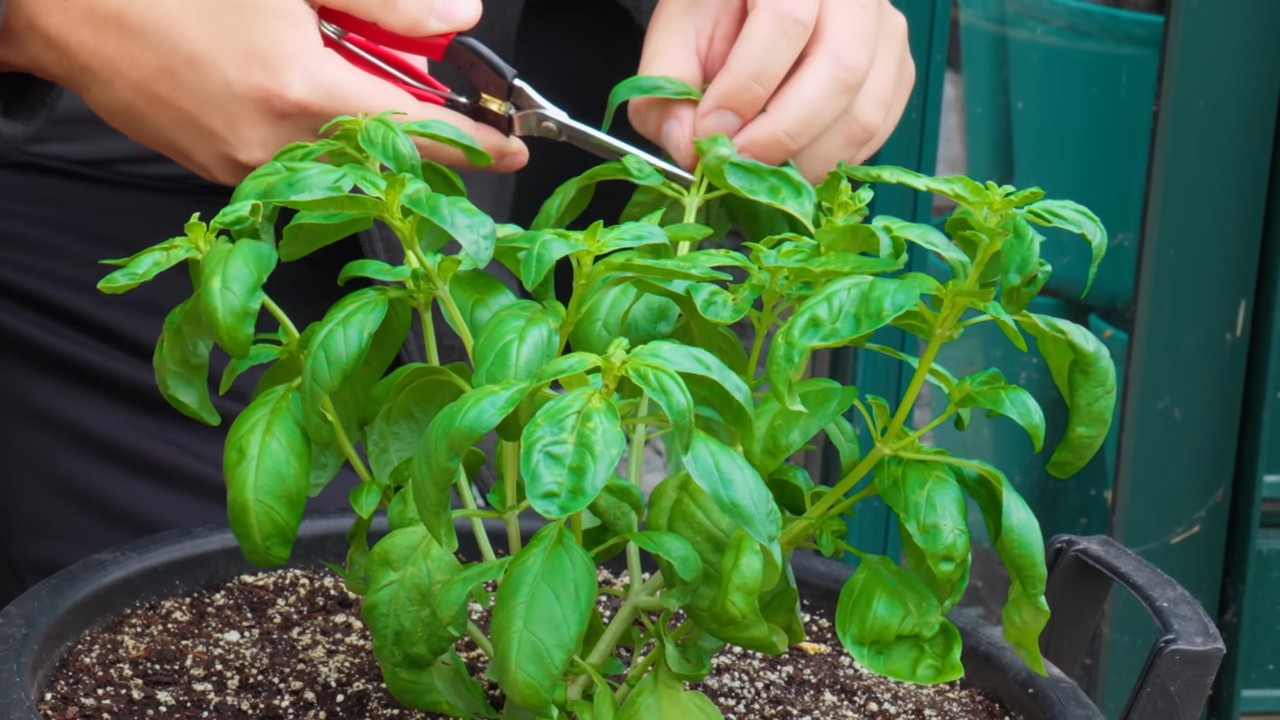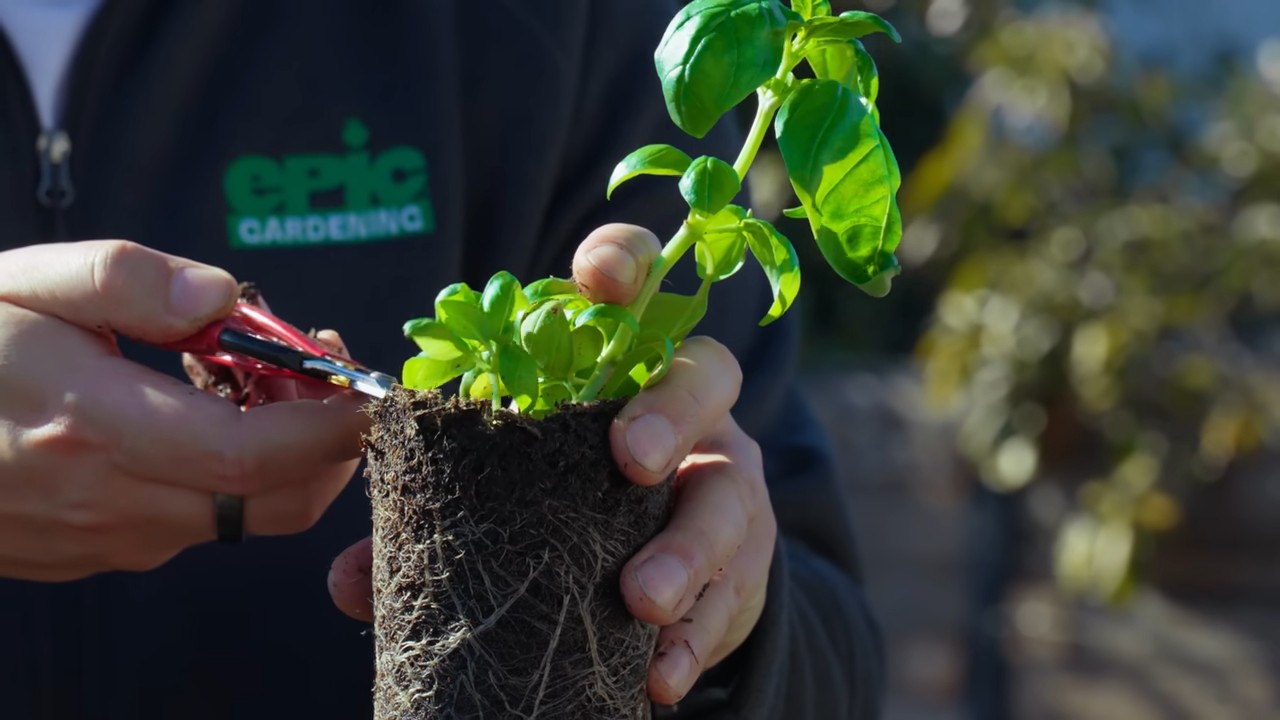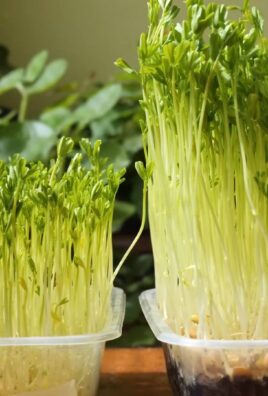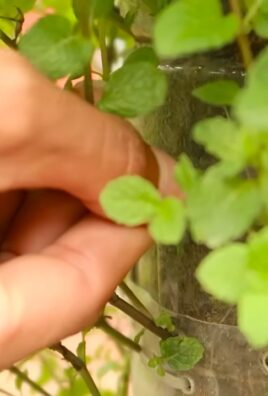Grow Basil Indoors? Absolutely! Imagine fresh, fragrant basil readily available right in your kitchen, no matter the season. Forget those sad, wilted supermarket herbs – we’re talking vibrant, flavorful basil at your fingertips. For centuries, basil has been revered not only for its culinary prowess but also for its medicinal properties and even symbolic meanings in various cultures. From ancient Rome, where it was believed to ward off evil, to Indian traditions where it’s considered sacred, basil boasts a rich and fascinating history.
But let’s be honest, sometimes life gets in the way, and tending an outdoor garden just isn’t feasible. That’s where the magic of indoor gardening comes in! I’m going to share some simple yet effective DIY tricks and hacks to help you successfully grow basil indoors. Whether you’re a seasoned gardener or a complete beginner, these tips will empower you to cultivate your own thriving basil plant, adding a touch of freshness and flavor to your meals year-round. Plus, who doesn’t love the satisfaction of growing their own food? Let’s get started!

Growing Basil Indoors: A Beginner’s Guide
Hey there, fellow plant enthusiasts! I’m so excited to share my experience with growing basil indoors. Fresh basil is a game-changer in the kitchen, and having it readily available year-round is a dream come true. Don’t worry if you’re a newbie – I’ll walk you through every step, from choosing the right pot to harvesting your fragrant leaves. Let’s get started!
Choosing the Right Basil Variety
First things first, let’s talk basil varieties. While all basil is delicious, some are better suited for indoor growing than others.
* Genovese Basil: This is your classic Italian basil, perfect for pesto and pasta sauces. It’s a reliable grower and readily available.
* Dwarf Basil: As the name suggests, dwarf basil varieties like ‘Spicy Globe’ stay compact, making them ideal for smaller spaces. They have a slightly spicier flavor.
* Lemon Basil: If you’re looking for a citrusy twist, lemon basil is a fantastic choice. It adds a bright, refreshing flavor to salads and teas.
* Thai Basil: With its anise-like flavor, Thai basil is a must-have for Asian cuisine. It’s also quite ornamental with its purple stems and flowers.
I personally love growing Genovese and Dwarf basil indoors. They’re both relatively easy to care for and provide a steady supply of fresh leaves.
Gathering Your Supplies
Before we dive into planting, let’s make sure you have everything you need. Here’s a checklist:
* Basil Seeds or Seedlings: You can start from seeds or purchase seedlings from a local nursery. I’ve had success with both methods.
* Pot: Choose a pot that’s at least 6 inches in diameter and has drainage holes. Good drainage is crucial to prevent root rot.
* Potting Mix: Use a high-quality potting mix that’s well-draining. Avoid using garden soil, as it can compact and suffocate the roots.
* Grow Lights (Optional but Recommended): If you don’t have a sunny windowsill, grow lights will provide the necessary light for your basil to thrive.
* Watering Can or Spray Bottle: For gentle watering.
* Small Shovel or Trowel: For planting.
* Fertilizer (Optional): A balanced liquid fertilizer can help boost growth.
Planting Your Basil
Okay, let’s get our hands dirty! Here’s how to plant your basil, whether you’re starting from seeds or seedlings.
Starting from Seeds
1. Prepare the Pot: Fill your pot with potting mix, leaving about an inch of space at the top. Gently pat down the soil.
2. Sow the Seeds: Sprinkle the basil seeds evenly over the surface of the soil. You don’t need to bury them too deep – just lightly press them into the soil.
3. Water Gently: Use a spray bottle to mist the soil thoroughly. You want to keep the soil moist but not waterlogged.
4. Cover with Plastic Wrap (Optional): Covering the pot with plastic wrap will help retain moisture and create a greenhouse effect. Remove the plastic wrap once the seedlings emerge.
5. Place in a Warm, Sunny Location: Basil seeds need warmth to germinate. Aim for a temperature of around 70-75°F (21-24°C).
6. Wait for Germination: Basil seeds typically germinate within 5-10 days. Be patient!
7. Thin the Seedlings: Once the seedlings have a few sets of true leaves, thin them out so that they’re spaced about 2-3 inches apart. This will give them room to grow.
Planting Seedlings
1. Prepare the Pot: Fill your pot with potting mix, leaving about an inch of space at the top.
2. Create a Hole: Dig a hole in the center of the pot that’s large enough to accommodate the seedling’s root ball.
3. Gently Remove the Seedling: Carefully remove the seedling from its container, being careful not to damage the roots.
4. Place the Seedling in the Hole: Position the seedling in the hole so that the top of the root ball is level with the surrounding soil.
5. Fill with Soil: Fill in the hole with potting mix, gently patting down the soil around the seedling.
6. Water Thoroughly: Water the seedling thoroughly until the water drains out of the bottom of the pot.
Caring for Your Indoor Basil
Now that your basil is planted, it’s time to provide it with the care it needs to thrive.
Light
Basil needs at least 6-8 hours of sunlight per day. If you don’t have a sunny windowsill, use grow lights. Place the grow lights about 6-12 inches above the plants. I use LED grow lights, and they work wonders!
Watering
Water your basil when the top inch of soil feels dry to the touch. Avoid overwatering, as this can lead to root rot. Water thoroughly until the water drains out of the bottom of the pot. I usually water my basil every 2-3 days, but this will depend on the humidity and temperature in your home.
Temperature
Basil prefers temperatures between 65-80°F (18-27°C). Avoid placing your basil near drafts or cold windows.
Fertilizing
Basil is a heavy feeder, so fertilizing regularly will help it grow strong and healthy. Use a balanced liquid fertilizer diluted to half strength. Fertilize every 2-4 weeks during the growing season (spring and summer).
Pruning
Pruning is essential for keeping your basil plant bushy and productive. When the plant is about 6 inches tall, pinch off the top set of leaves. This will encourage the plant to branch out and produce more leaves. Continue to pinch off the top sets of leaves regularly throughout the growing season.
Important Pruning Tip: Always prune above a leaf node (the point where leaves emerge from the stem). This will encourage new growth from that node.
Pest Control
Indoor basil plants are generally less susceptible to pests than outdoor plants, but they can still be affected by aphids, spider mites, and whiteflies. If you notice any pests, try spraying them with insecticidal soap or neem oil. I’ve found that a strong blast of water from the sink can also dislodge many pests.
Harvesting Your Basil
The best part about growing basil indoors is harvesting your own fresh leaves!
* When to Harvest: You can start harvesting basil leaves when the plant is about 6-8 inches tall.
* How to Harvest: Pinch off the top sets of leaves, as described in the pruning section. This will encourage the plant to continue growing.
* Harvest Regularly: The more you harvest, the more your basil plant will produce. Don’t be afraid to use your basil!
Troubleshooting
Even with the best care, you might encounter some problems while growing basil indoors. Here are some common issues and how to fix them:
* Yellowing Leaves: This could be a sign of overwatering, underwatering, or nutrient deficiency. Check the soil moisture and adjust your watering accordingly. If the soil is dry, water thoroughly. If the soil is soggy, allow it to dry out before watering again. You may also need to fertilize your basil plant.
* Leggy Growth: This is usually caused by insufficient light. Move your basil plant to a sunnier location or provide it with grow lights.
* Drooping Leaves: This could be a sign of underwatering or extreme heat. Water your basil plant thoroughly and make sure it’s not exposed to direct sunlight during the hottest part of the day.
* Root Rot: This is caused by overwatering and poor drainage. Make sure your pot has drainage holes and that you’re not overwatering your basil plant. If you suspect root rot, you may need to repot your basil plant in fresh potting mix.
Enjoying Your Fresh Basil
Now that you have a bountiful supply of fresh basil, it’s time to put it to good use! Here are some of my favorite ways to enjoy fresh basil:
* Pesto: Homemade pesto is so much better than store-bought.
* Pasta Sauces: Add fresh basil to your favorite pasta sauces for a burst of flavor.
* Salads: Sprinkle fresh basil on salads for a refreshing touch.
* Pizza: Top your homemade pizza with fresh basil after baking.
* Teas: Add fresh basil to hot or iced tea for a unique flavor.
* Caprese Salad: A classic combination of fresh mozzarella, tomatoes, and basil.
Growing basil indoors is a rewarding experience that will provide you with fresh, flavorful leaves year-round. With a little care and attention, you can enjoy the taste of summer no

Conclusion
So, there you have it! Mastering the art of growing basil indoors is not only achievable but also incredibly rewarding. Forget those wilted, overpriced bunches from the grocery store. With a little patience and this simple DIY trick, you can have a constant supply of fresh, fragrant basil right at your fingertips.
Why is this a must-try? Because it empowers you to take control of your ingredients, ensuring you always have the highest quality basil for your culinary creations. Imagine the burst of flavor in your homemade pesto, the aromatic addition to your Caprese salad, or the vibrant garnish on your favorite pasta dish – all thanks to the basil you nurtured yourself. Plus, it’s a fantastic way to bring a touch of green into your home, especially during the colder months when outdoor gardening is limited.
But don’t stop there! Experiment with different varieties of basil. Try growing Genovese basil for classic Italian dishes, Thai basil for Asian-inspired cuisine, or lemon basil for a citrusy twist. You can also explore different containers, from repurposed mason jars to stylish ceramic pots, to find what works best for your space and aesthetic. Consider using grow lights to supplement natural sunlight, especially if you live in a region with limited daylight hours. This will ensure your basil plants receive the energy they need to thrive.
The beauty of this DIY trick lies in its simplicity and adaptability. It’s a project that anyone can undertake, regardless of their gardening experience. And the payoff – a continuous supply of fresh, flavorful basil – is well worth the effort.
We wholeheartedly encourage you to give this method of growing basil indoors a try. It’s a game-changer for any home cook or gardening enthusiast. Once you experience the satisfaction of harvesting your own basil, you’ll never go back to store-bought again.
Don’t be shy! Share your experiences with us. Let us know what varieties you’re growing, what challenges you’ve encountered, and what successes you’ve celebrated. Post pictures of your thriving basil plants on social media and tag us. We’re eager to see your green thumbs in action and learn from your unique experiences. Together, we can create a community of indoor basil growers, sharing tips, tricks, and inspiration. Happy growing!
Frequently Asked Questions (FAQs)
Q: What kind of basil is best for growing indoors?
A: While you can grow almost any type of basil indoors, some varieties tend to thrive better than others. Genovese basil is a popular choice due to its classic flavor and relatively compact size. Thai basil is another excellent option, offering a unique anise-like flavor that’s perfect for Asian dishes. Lemon basil, with its refreshing citrusy aroma, is also a great choice. Bush basil varieties, like Spicy Globe basil, are naturally smaller and more manageable for indoor growing. Experiment with different varieties to find your personal favorite!
Q: How much sunlight does indoor basil need?
A: Basil thrives in bright, direct sunlight. Ideally, your indoor basil plant should receive at least 6-8 hours of sunlight per day. A south-facing window is usually the best option. If you don’t have access to sufficient natural light, consider using grow lights. Fluorescent or LED grow lights can provide the necessary light spectrum for healthy basil growth. Position the grow lights a few inches above the plants and keep them on for 12-14 hours per day.
Q: What kind of soil should I use for growing basil indoors?
A: Basil prefers well-draining soil that is rich in organic matter. A good potting mix specifically formulated for herbs is an excellent choice. You can also create your own potting mix by combining equal parts of potting soil, perlite, and compost. Perlite helps improve drainage, while compost provides essential nutrients. Avoid using garden soil, as it can be too heavy and may contain pests or diseases.
Q: How often should I water my indoor basil plant?
A: Water your basil plant when the top inch of soil feels dry to the touch. Avoid overwatering, as this can lead to root rot. When you water, water thoroughly until the water drains out of the bottom of the pot. Make sure the pot has drainage holes to prevent water from accumulating. During the warmer months, you may need to water more frequently than during the cooler months.
Q: How do I harvest basil leaves from my indoor plant?
A: The best way to harvest basil leaves is to pinch or cut them off just above a leaf node (the point where leaves grow from the stem). This encourages the plant to branch out and produce more leaves. Avoid removing more than one-third of the plant’s leaves at a time, as this can stress the plant. Regularly harvesting basil leaves will also help prevent the plant from flowering, which can reduce the flavor of the leaves.
Q: Why are my basil leaves turning yellow?
A: Yellowing basil leaves can be caused by several factors, including overwatering, underwatering, nutrient deficiencies, or pests. Check the soil moisture to ensure you’re not overwatering or underwatering. If the soil is consistently wet, allow it to dry out before watering again. If the soil is dry, water thoroughly. Consider fertilizing your basil plant with a balanced liquid fertilizer to address potential nutrient deficiencies. Inspect the leaves for signs of pests, such as aphids or spider mites.
Q: How do I prevent pests from attacking my indoor basil plant?
A: Regularly inspect your basil plant for signs of pests. If you spot any pests, you can try washing them off with a strong stream of water. You can also use insecticidal soap or neem oil to control pests. Avoid using harsh chemicals, as they can harm the plant and make the leaves unsafe to eat. Good air circulation can also help prevent pest infestations.
Q: Can I grow basil from seed indoors?
A: Yes, you can easily grow basil from seed indoors. Start by sowing the seeds in a seed-starting tray or small pots filled with seed-starting mix. Keep the soil moist and warm (around 70-75°F). The seeds should germinate within a week or two. Once the seedlings have developed a few sets of true leaves, you can transplant them into larger pots.
Q: How long will my indoor basil plant last?
A: With proper care, an indoor basil plant can last for several months. However, basil is an annual plant, meaning it completes its life cycle in one growing season. Eventually, the plant will start to decline and produce fewer leaves. You can prolong the life of your basil plant by regularly pruning it, providing it with adequate sunlight and water, and fertilizing it regularly. You can also take cuttings from your basil plant and root them to create new plants.




Leave a Comment